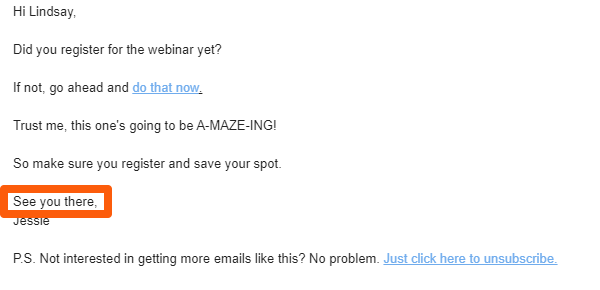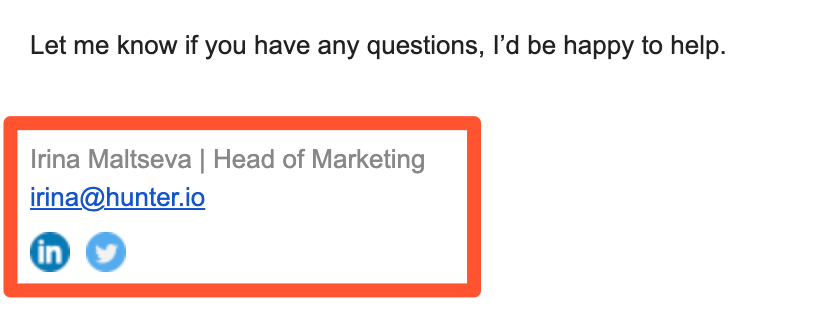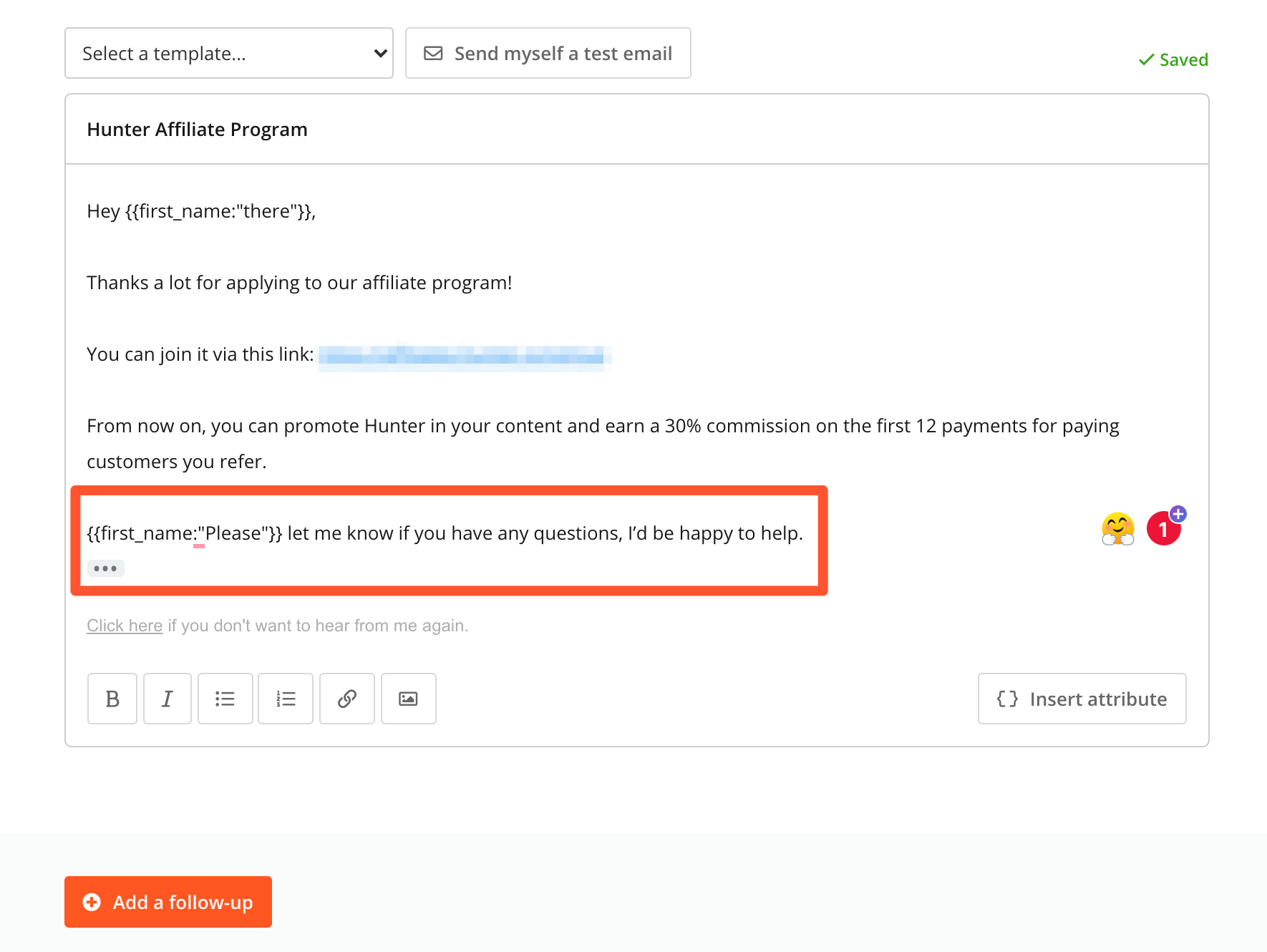How to End an Email (Don’t Miss These 30 Sign-Off Examples)

You’ve got a great email typed out.
Well...almost. Now you just need an ending that holds onto the readers’ attention and makes them want to keep reading and engaging with your brand.
We get it—email endings aren’t easy! They have a big job: transitioning from body content to a direct call-to-action.
When your ending is less than optimal, your email isn't as effective. And less-than-effective emails get ignored and deleted. Read on to learn how to craft effective email endings and check out our professional email closing examples.
1. The anatomy of an email ending
Your email’s ending is far more than your signature. Your signature is actually just one of three components of the email ending: your closing thoughts, the sign-off, and your signature.
Closing thoughts
Your email’s closing thoughts are the last sentence or two that bring the body of the email to its logical closing.
Often, these closing thoughts reiterate your email’s goal or emphasize your enthusiasm, gratitude, or excitement about the topic you discussed in the email. A few examples of email closing thoughts include:
- “Thanks again for reaching out! I’m looking forward to speaking with you further.”
- “Again, I really appreciate you bringing this to my attention. I will see to it that we address this issue in a timely manner.”
- “It was great to speak with you today. I’ll be in touch soon to schedule our next call.”

The closing thoughts are where you concretely express your goal or plan related to the topic discussed in the email.
Because this section is its own paragraph, it stands out from your email’s body content and ensures the recipient does not miss this important information.
Your closing thoughts are also where you set the tone for your next email with the recipient. If you’re asking them to schedule a call with you, your closing thoughts should be warm, inviting, and enthusiastic about the call.
If the email was a response to information they shared, your closing thoughts should make it clear that you take their concerns seriously and you will take the action you promised you would take earlier in the email.
The sign-off
After your closing thoughts, you sign off. Common email sign-offs include:
- Best regards
- Sincerely
- Thanks
- Best

These short phrases signal that the email is over. Just like your closing thoughts, it’s important to get your sign-off’s tone just right. Otherwise, you can potentially miscommunicate and possibly even offend your email recipient.
The signature
The last component of your email ending is your signature. For personal emails, all you need is your name—or even just your initials.

But in a professional email, particularly a cold email, a well-crafted signature has substance.
Just like the header and footer in an email newsletter template includes all the sender’s vital information like their website and phone number, your professional email signature includes all the information the recipient might need about you.
This includes:
- Your full name
- Your job title
- Your email address (yes, even though it’s an email, you still need to include this)
- Your phone number
- A link to your website
- Your social media profiles
By including all of this information in your signature, you make it easy for the recipient to get back to you easily and find any information they need.
2. How to choose the right sign off
Certain sign-offs work for just about any email. These include:
- Best
- Cheers
- Sincerely
- Best regards
- Warmly
- All the best
You can’t go wrong with these email closings, but they also aren’t always the best choice for the email you’re writing.
There's no need to always use the same sign-off. When you can customize your sign-off to the type of email you’re sending, do it—this gives the email a more cohesive feel and emphasizes your email’s goal.
What’s your goal?
Are you sending a cover letter for a job application or emailing a friend? Do you want them to make an appointment? Are you simply confirming your interest in something or following up on an earlier conversation?
The reason for your email determines which sign-off you should use.
Take a look at the different ways to sign off an email depending on your specific goal:
- Making a request
When you’re emailing with a request, it’s important that you express your gratitude even before the recipient responds.
By doing this, you’re communicating that you respect them and value the answer, benefit, time, or other asset of theirs you’re requesting.
Appropriate email sign offs for this scenario include:
- Thank you in advance
- I appreciate your help
These sign-offs are also appropriate when you’re following up on a request.
2. Asking a question
When your email’s primary focus is to ask the recipient a question, you can allude to the question in your sign-off. A few examples of appropriate sign-offs for question emails include:
- Please let me know
- I’m looking forward to your response
As you can see, there’s some crossover between the appropriate sign-offs for request and question emails.
You’ll see this with the other sign-off categories too. Because a sign-off is essentially a “goodbye for now, but let’s keep this conversation moving,” certain phrases can work in a variety of scenarios.
3. Expressing gratitude
When your email is expressing gratitude, like thanking the receiver for making a purchase, booking a call, or personally helping you with something, it’s important that you make your appreciation clear.
A few sign-offs that can accomplish this include:
- Thanks
- Thank you very much
- I really appreciate your help/effort/insight
4. Introduce yourself
When your email’s purpose is to introduce yourself, your sign-off should communicate your enthusiasm about the new connection and express your eagerness to continue your relationship. A few sign-offs that can do this are:
- It’s great to connect
- I can’t wait to chat more
- Thanks for connecting
5. Request further interaction
You might also be sending an email asking the recipient to schedule a call with you or send an email back. When you’re signing off this kind of email, the following sign-offs can work well:
- Let me know your thoughts
- Let’s connect
- Call me any time
Sign-offs to avoid (and why)
Just like there are a lot of great email sign-offs to use, there are also a bunch that aren’t so great, especially for professional emails and business communication. Let’s get the obvious ones out of the way first:
- XOXO (and any variation on this like hugs, kisses, love, etc.)
- Take care
- Please get back to me
- Looking forward to hearing from you
- Any emoji
Save these sign-offs for your family and significant other and opt for a more professional sign-off when you're sending a business email. Anything demanding a response, even when wrapped in a pleasantry like “please get back to me,” is demanding and can be off-putting to your recipient.
You might be surprised to see other sign-offs, like “take care” and “looking forward to hearing from you” on that list.
Although these sign offs can initially seem reasonable, they can actually convey messages you wouldn’t want to convey to a professional connection.
“Take care” can imply that there’s a reason why the recipient needs to be wary, and much like “please get back to me,” “looking forward to hearing from you” can come across as demanding.
Other sign-offs should only be used in very specific types of communication. For example, “have a blessed day” has religious undertones and should only be used when you know your recipient will appreciate this sign off.
Beyond considering your email’s goal, consider its formality level when choosing the right sign-off.
Some sign-offs, like “your friend” and “talk soon” are perfectly acceptable in casual emails, but are not considered professional email closings.
Similarly, save any closing line that’s just your name or initial for emails with your close friends and loved ones.
3. Should I include a postscript?
You’ve seen postscripts in emails before. They’re the final concluding sections that come after the sender’s signature and usually make some kind of offer or add a cheeky closing thought. They start with the letters P.S.
In the days of handwritten and typewritten letters, a postscript was any additional thought the writer had after concluding their letter.
Today, they’re technically obsolete—if you have additional content to add to your email, you can just click on the section in the body where you want to add it and type in your additional thoughts.
So why do so many people include postscripts in their emails?
Because they’re eye-catching. People generally don’t read emails; they skim them.
So if you have anything that needs to stand out, like a limited time offer, an additional call-to-action, or even just a witty comment to engage the recipient, add it in your postscript.
4. Getting your email endings just right
Keep the following tips in mind to perfect your email endings:
Make your email’s goal clear
This one's obvious, but it’s worth repeating: your email’s ending is the last part of the email your recipient reads.
This is where they make their last impression, the one that sticks out in their minds when they think of your brand and the offer you made in the email. Make sure your ending reiterates the reason why you sent the email.
Don’t assume anything
This is especially important when you’re sending cold emails. You can’t assume your reader knows anything about you, your brand, or your offer.
Just like you need to reiterate the reason for your email in your ending, don’t assume your reader knows how to take the action you’re asking them to take.
Here’s an example of an ending that makes an assumption versus one that doesn’t:
Assumption: Sign up now and start getting amazing content in your inbox.
No assumption: Click the link below to sign up and start getting amazing content in your inbox.
See how the second ending tells the reader exactly what to do, rather than assuming they know what to do?
Keep your relationship to the recipient in mind
When we said it’s important to strike the right tone in your email ending, this is what we meant. With cold emailing, the first email somebody receives from you sets the tone for your relationship going forward.
If your tone is too casual, they might not take your offer as seriously as you want them to and if it’s not casual enough, you could come across as stuffy or an otherwise poor fit for their needs.
Don’t make your ending too wordy (or too short!)
Keep it to three or four lines at the absolute maximum. Your closing thoughts should be just a sentence or two, then your sign-off, followed by your signature. That’s everything it needs to include, and that’s all it should include.
Personalize your email ending
Give your email ending some personal pizazz! When you send a cold email, you aren’t just introducing yourself.
You’re introducing your brand. Just like your brand has a color palette and other brand assets, it has a specific tone of voice as well.
It might be a super casual tone that talks to the reader like they’re an old friend, or it might be a more reserved, sophisticated tone of voice that makes the reader feel like they’re part of an exclusive club.
In either case, write your email ending in this tone to underscore who you are as a brand and how you’d like your reader to perceive that brand.
There’s another side to personalizing your email ending: personalizing it to your recipient. If you had a personal interaction with the receiver, allude to it in your closing thoughts or sign-off.
For example, if the receiver helped you locate some information, an appropriate professional closing might be “thanks again for helping me find that information!”
With cold emails, personalizing them in a way that feels genuine is a little more challenging. After all, they aren’t personalized in the way a one-on-one email can be.
One way to get around this challenge is to opt for broad, general email endings that work for everybody on your outreach list. Sometimes, a friendly, on-brand ending is all you need to connect with the reader.
Other times, you need something more overtly personalized. And when you need to personalize cold emails at scale, you can do it with Hunter Campaigns and custom attributes.

Custom attributes enable you to personalize your emails even further, displaying things like your recipient's name, company name, job title, and more.
Don’t introduce new information in the ending
The time and place to introduce new information is not your email ending.
When you need to introduce something, do it in your email’s opening. Your email ending is for driving home the information you’ve already provided and setting the stage for the next step in your relationship with the recipient.
End every email on a high note
Although it can be tempting to do, don’t give your emails generic endings. Readers notice when an email is a word-for-word template, and that’s never a good look for your brand.
You can avoid that cookie-cutter look and feel by putting as much care into crafting a professional sign-off as you put into writing the perfect subject line and the most captivating opening.
However, a cold email template can be a great place to find inspiration and get the creative juices flowing for your impossible-to-ignore email ending. Check out Hunter’s cold email templates to get started.




 Send cold emails with Hunter
Send cold emails with Hunter